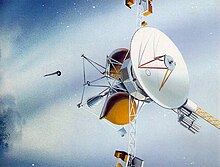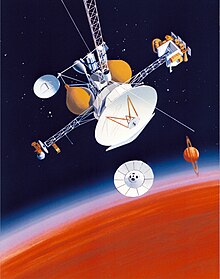Mariner Mark II
This article includes alist of references,related reading,orexternal links,but its sources remain unclear because it lacksinline citations.(March 2013) |


Mariner Mark IIwasNASA's planned family of uncrewedspacecraftfor the exploration of theouter Solar Systemthat were to be developed and operated byJPLbetween 1980 through the year 2010.
Summary[edit]
After the"flagship"multibillion-dollar missions of the 1970s, in the 1980s NASA was looking for a new, more affordable direction for the 1990s and beyond. Two projects were conceived by NASA's Solar System Exploration Committee in 1983, thePlanetary Observer program,and Mariner Mark II.
The Observer program, starting with theMars Observer,was envisioned as a series of low-cost missions to theinner Solar System,based on commercial Earth satellites, while the Mariner Mark II was to be a series of large spacecraft for the exploration of theouter Solar System.
Mariner Mark II spacecraft were to use common design, hardware and software solutions, much of it derived from previous missions such asVoyagerandGalileoas well as select new technologies, such as advanced gyroscopes, all with the aim of cutting costs. It was hoped that this new approach would reduce the mission costs to about $400 million each, about half the price of Galileo.
The first two missions of the project were to be a mission to Saturn and its moon Titan, theSaturn Orbiter/Titan Probe,or SOTP (laterCassini) and theComet Rendezvous Asteroid Flyby(CRAF), both of which were approved by Congress in 1990.
Other planned Mariner Mark II-based spacecraft were anESAled follow-on to CRAF, theComet Nucleus Sample Returnor CNSR (laterRosetta,without the sample return);Pluto Fast Flyby,a flyby of Pluto (laterPluto Kuiper Express,eventually realized asNew Horizons); and aNeptune Orbiterwith an atmospheric probe.
However, congressionally imposed reductions to FY 1992–93 funding requirements forced NASA to terminate the CRAF mission and to delay theCassinilaunch from April 1996 to October 1997. In order to save it, NASA was forced to significantly redesignCassinito reduce the total program cost, mass and power requirements.
NASA has had to replace theMariner Mark IIprogram with the lower-costDiscovery Program.
See also[edit]
External links[edit]
- "Assessment of CRAF and Cassini missions"Archived2009-03-18 at theWayback Machineby Dr. Robert O. Pepin, chair of the Committee on Planetary and Lunar Exploration of theNational Academy of Sciences,1988
- "On the CRAF/Cassini Mission"Archived2009-03-18 at theWayback Machineby DDr. Louis J. Lanzerotti, chair of the Space Studies Board, of theNational Academy of Sciences,1992
- "Exploring the Trans-Neptunian Solar System"Archived2009-03-18 at theWayback MachineNational Academy of Sciences



